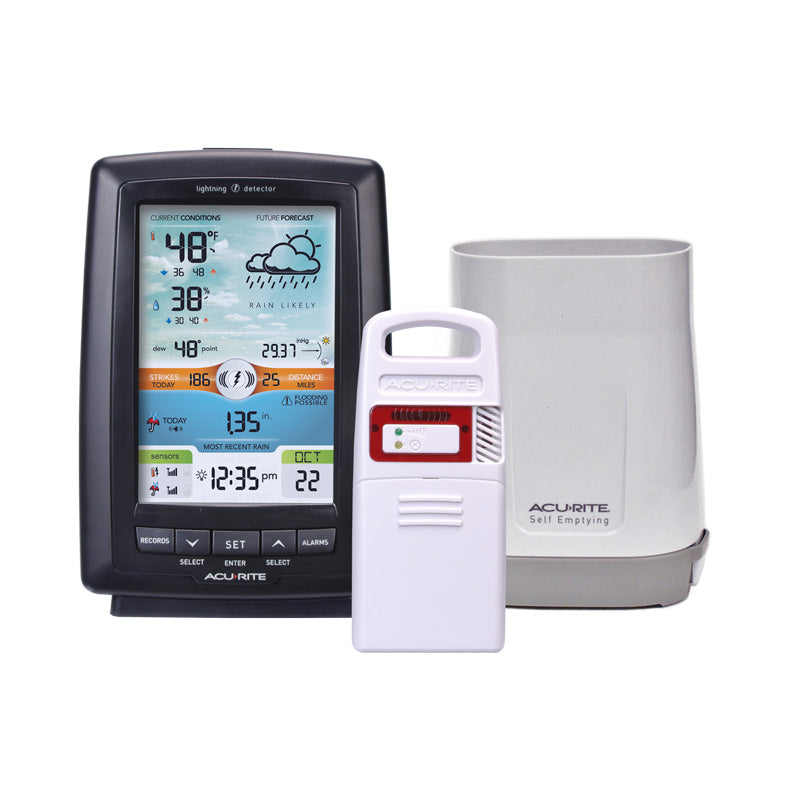Extreme weather events are becoming more common across the world, and few can be as dangerous and devastating as a flash flood. During or after heavy rains, fast-moving torrents of water and debris can surge in seconds and carve a path of destruction through residential areas. By the time you receive a flash flood warning, you may have mere minutes or even seconds to react and get to safety.
Here is how to determine if you live in an area that is susceptible to severe flooding and how AcuRite weather technologycan help you stay prepared and give you a head start on evacuating before a flash flood warning is issued.

Prepare for Quickly Developing Flash Floods
Depending on where you live, you may already be at risk for flash flooding before the first drops of rain reach the ground. Generally speaking, flash floods affect areas where water tends to naturally collect, like near creeks and rivers, dry lake beds, or low-lying valleys. They can be caused by torrential rain, melting snow and ice, or damage to levees and dams.
Flash floods typically occur within six hours of a severe thunderstorm, hurricane, or other extreme rain event, but that doesn’t mean you will have that much time to evacuate. For example, long periods of heavy rain can eventually overwhelm saturated soil and cause excess water to flow downhill. However, in areas where the soil is dry or arid and can’t easily absorb water, just a few hours of downpour can wreak havoc. That’s why preparing before a flash flood warning is key.
Stay Alert Near Water
If you live near a river, creek, drainage ditch, reservoir, dam, or any other area where water tends to collect, be aware that even a gentle trickle of water can surge into floodwater during a downpour. That’s why it is important to understand the different kinds of flood advisories the National Weather Service may issue.
A “Flash Flood Watch” simply means that conditions are favorable for flash flooding, whereas a “Flash Flood Warning” indicates that flood is imminent or occurring. The same logic applies to a regular “Food Watch” and “Flood Warning,” as well as coastal flooding alerts. However, a county or statewide alert may not take into consideration the specific terrain where you live, which is why monitoring local conditions yourself is critical.
The AcuRite Weather Station with Rain Gauge and Lightning Detection has programmable weather alarms for barometric pressure and rainfall. It can also sense lightning strikes within 25 miles of your home to help alert you to incoming thunderstorms. The automatic self-emptying rain collection cup can measure average rainfall over the previous 48 hours and provides historical rainfall data to help you compare to prior years.

Leave in a Flash
When a flash flood warning is announced, the National Weather Service has clear directions for what to do: Turn Around Don’t Drown. Follow all local evacuation orders without delay, and don’t attempt to wait it out. Any water level is dangerous during a flash flood because the speed, strength, and intensity of flowing water can intensify in an instant and carry debris, property, and people with it. Just two feet of sustained streaming water can sweep a car downstream, which means even ankle-deep water is dangerous for adults, children, and pets. Stay away from flooded areas and move to higher ground immediately, and exercise extreme caution on flooded roads — especially at night, when flooding water is difficult to see.
Make sure to keep emergency kits in your home, office, and all vehicles since there may be limited time to pack essentials once the rain starts to accumulate. Bring a gallon of potable water for each person in your party, as well as a first-aid kit; vacuum-packed food and snacks; emergency equipment like waterproof matches, flares, and flashlights; raingear like plastic ponchos, tarps, and reflective vests; and external chargers and batteries for electronic devices. Portable weather gear, like the AcuRite Portable Lightning Detector, should be a staple of your emergency kit. At the same time, the AcuRite Iris (5-in-1) Weather Station with Wi-Fi Connection to Weather Underground and Lightning Option for remote monitoring can help you stay connected to your weather station from your mobile device anywhere you need to go.
Prepare and Practice for Floods
You can’t control a flash flood, but you can control how much you and your family prepare for this life-threatening situation. Make an evacuation plan and familiarize yourself with routes to high ground, as well as local shelters or emergency meeting locations in your area. If you are in a particularly high-risk place, don’t wait until the last second to make a decision — use your AcuRite weather technology as an early warning system so that a flash flood warning doesn’t leave you caught in the rain.

